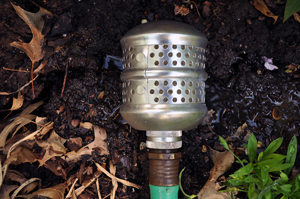Tree Watering for Summer Survival
Return to Trees and Shrubs Agent Articles
 Who knows what to expect next with the wild and wacky Kansas City weather patterns. Will it be a hot, dry summer or cooler and moist? I know what I am hoping for but we don’t always get our wishes.
Who knows what to expect next with the wild and wacky Kansas City weather patterns. Will it be a hot, dry summer or cooler and moist? I know what I am hoping for but we don’t always get our wishes.
Trees are an investment in the future and are sometimes the first to suffer under dry or drought conditions. Care must be taken to water properly for good growth.
Newly planted and young trees
Newly-planted and young, establishing trees are most in need of timely watering for summer survival. A young tree can be defined as one planted in the last five years or so. The longer the tree has had a chance to develop strong roots the more likely it is to tolerate summer stress. Trees planted in the last year or two are at greatest risk. Correct watering is one of the most difficult practices to teach people. It is difficult because the effects are below ground, out of sight. If only there was a recipe for how to water. Unfortunately there is no cookbook recipe because each site, soil type and conditions vary. Everyone asks for a simple guide to watering. How much is enough and how often to apply?
As a general rule of thumb, a newly-planted or young tree will need at least ten gallons of water per week; depending on soil type and tree size. The secret to helping a tree survive and thrive during summer is getting the water to soak deeply into the soil so it evaporates slowly and is available to the roots longer. The water should soak in and not quickly run off the planting area.
A trick to try when watering trees is to punch a small hole in a five gallon bucket and fill it with water. Let the water drip out and then refill for the estimated ten gallons. Move the bucket to a new location around the tree each time it is filled to soak the entire root mass. The tricky part of this tip is to properly place the bucket.
Newly-planted trees have their roots, for the most part, in the root ball. So be sure to soak the recently planted root ball, as well as the soil area just outside the ball where the new roots will be forming. Setting the bucket several feet away from the establishing root ball will do the tree no good. Setting in the same location each time will not evenly distribute the root growth.
Larger or more-established trees that have been planted for only a couple of years will require more water, as they have more roots and a bigger canopy. Set the bucket out away from the trunk, because the root development has moved passed the root ball, but under the drip line of the tree. Move the location of the bucket to soak the majority of the roots under the drip line of the tree. Maturing trees planted for three to five years may need thirty, forty or even fifty gallons of water on a regular basis.
When using this method, or any other, be sure to check the soil to make sure there is enough moisture to keep the roots damp. Also remember, the signs of not enough water and drought stress are very similar to over-watering. The goal is to water deeply and less frequently.
Three to five year old trees
Trees that have been planted for three to five years will require less-frequent applications of water, as the root system is more extensive. When watering trees it is best to thoroughly soak the soil, and then allow the water to drain away and evaporate before applying additional applications. Clay soils tend to retain water. Excess moisture can result in over-watering and drowning of the tree. Apply a thorough application about every two- to three-weeks.
Five year old trees or older
Trees that have been in the ground for more than five years should be soaked about every four weeks to stay in good condition, depending on the species. Supplying this added moisture will help increase growth rate. Old, mature trees may not need supplemental watering except in times of extreme drought stress.
Evergreens in Kansas City
Evergreens are most affected by drought conditions so be sure to supply timely applications to avoid serious injury during dry periods. Here in Kansas City, they need special attention throughout their lifetime. For specific instructions on caring for evergreens, check out this article: Growing Evergreens in Kansas City.
Want more seasonal lawn and garden tips?
Sign up for Knowledge for Life , our monthly newsletter. You'll receive articles from our Horticulture agents, plus information about cooking, nature, health, upcoming events, and more.
Still have questions? The Garden Hotline is staffed by trained EMG volunteers and Extension staff who will assist you with questions.
Phone: (913) 715-7050
Email: garden.help@jocogov.org